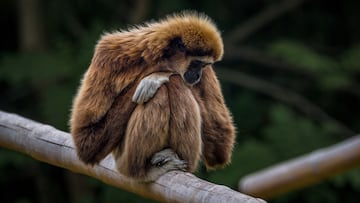Japanese zoo solves mystery of the monkey who got pregnant despite living alone
The idea that Momo the monkey became pregnant without any contact with a male partner had them baffled... until now.


Ok, so immaculate conception it was not. The employees of the city of Kujukushima zoo in Japan have solved the mystery of the pregnancy of the monkey Momo, who lives in the zoo and became pregnant despite remaining alone in a cage and having no obvious contact with any other primates in the enclosure.
Puzzle solved over Momo the pregnant monkey
However, it wasn’t now when the workers noticed this event, but two years ago. As she continues to live in the zoo with her offspring, the reason for her pregnancy has been revealed. To understand the origin of the event, scientists analyzed hair and feces samples from the primates to trace their biological origin. With this, it was revealed that the father of the creature was Itoh, a 34-year-old gibbon.
- What is the difference between a tornado watch and a tornado warning?
- H5N1 bird flu spreads between minks in mammal first
But it was not through a biological finding, but from the discovery of a hole in the wall of the zoo’s exhibition room that Momo and Itoh occupied. This was stated via media outlet Vice News. “We believe that it is very likely that on one of the days that Itoh was in the exhibition space, they copulated through a hole,” the zoo said.
The same media also detailed that the investigation process lasted for over two years due to the difficulties in collecting samples from the monkeys. In fact, due to the discovery, the zoo managers have covered the hole to avoid any future unplanned pregnancies. Until now, Momo lived in a cage with large bars covered with wires.
Additionally, the workers are considering relocating Itoh with his family. The Japanese zoo assured us that this type of event is unusual as they normally pair gibbon primates after a series of trials and errors so that the monkeys can familiarize themselves with each other. In the wild, gibbons select their partners based on their physical appearance, social behavior, and vocalization, according to the aforementioned media outlet.
Other primate pairings
Pairing of monkeys in zoos is a common practice to ensure genetic diversity among captive populations and promote socialising among individuals.
Related stories
In 2019, the San Francisco Zoo paired a group of squirrel monkeys with new mates to increase genetic diversity in their captive population. We also saw endangered cotton-top tamarins paired at the Saint Louis Zoo a year earlier as part of a breeding program to help conserve the species. For the same reason, in 2017, the Toronto Zoo successfully hooked up a group of ring-tailed lemurs with new partners.
Zoos and conservation organizations around the world are constantly working to pair and breed monkeys in captive populations to promote genetic diversity and ensure the survival of endangered species.

